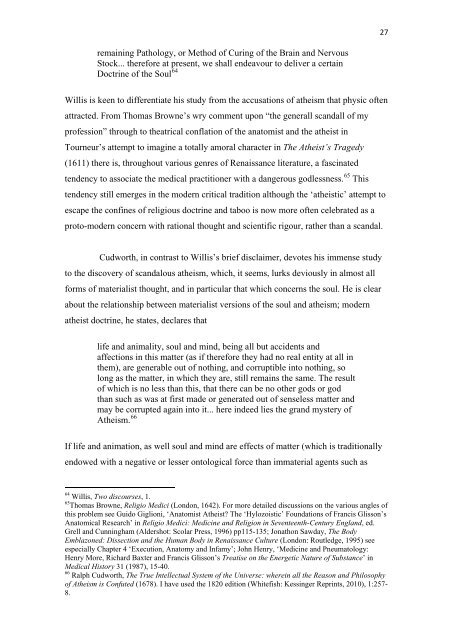Medical Science and the Anatomia Animata in Milton's Paradise Lost
Medical Science and the Anatomia Animata in Milton's Paradise Lost
Medical Science and the Anatomia Animata in Milton's Paradise Lost
Create successful ePaper yourself
Turn your PDF publications into a flip-book with our unique Google optimized e-Paper software.
ema<strong>in</strong><strong>in</strong>g Pathology, or Method of Cur<strong>in</strong>g of <strong>the</strong> Bra<strong>in</strong> <strong>and</strong> Nervous<br />
Stock... <strong>the</strong>refore at present, we shall endeavour to deliver a certa<strong>in</strong><br />
Doctr<strong>in</strong>e of <strong>the</strong> Soul 64<br />
Willis is keen to differentiate his study from <strong>the</strong> accusations of a<strong>the</strong>ism that physic often<br />
attracted. From Thomas Browne’s wry comment upon “<strong>the</strong> generall sc<strong>and</strong>all of my<br />
profession” through to <strong>the</strong>atrical conflation of <strong>the</strong> anatomist <strong>and</strong> <strong>the</strong> a<strong>the</strong>ist <strong>in</strong><br />
Tourneur’s attempt to imag<strong>in</strong>e a totally amoral character <strong>in</strong> The A<strong>the</strong>ist’s Tragedy<br />
(1611) <strong>the</strong>re is, throughout various genres of Renaissance literature, a fasc<strong>in</strong>ated<br />
tendency to associate <strong>the</strong> medical practitioner with a dangerous godlessness. 65<br />
This<br />
tendency still emerges <strong>in</strong> <strong>the</strong> modern critical tradition although <strong>the</strong> ‘a<strong>the</strong>istic’ attempt to<br />
escape <strong>the</strong> conf<strong>in</strong>es of religious doctr<strong>in</strong>e <strong>and</strong> taboo is now more often celebrated as a<br />
proto-modern concern with rational thought <strong>and</strong> scientific rigour, ra<strong>the</strong>r than a sc<strong>and</strong>al.<br />
Cudworth, <strong>in</strong> contrast to Willis’s brief disclaimer, devotes his immense study<br />
to <strong>the</strong> discovery of sc<strong>and</strong>alous a<strong>the</strong>ism, which, it seems, lurks deviously <strong>in</strong> almost all<br />
forms of materialist thought, <strong>and</strong> <strong>in</strong> particular that which concerns <strong>the</strong> soul. He is clear<br />
about <strong>the</strong> relationship between materialist versions of <strong>the</strong> soul <strong>and</strong> a<strong>the</strong>ism; modern<br />
a<strong>the</strong>ist doctr<strong>in</strong>e, he states, declares that<br />
life <strong>and</strong> animality, soul <strong>and</strong> m<strong>in</strong>d, be<strong>in</strong>g all but accidents <strong>and</strong><br />
affections <strong>in</strong> this matter (as if <strong>the</strong>refore <strong>the</strong>y had no real entity at all <strong>in</strong><br />
<strong>the</strong>m), are generable out of noth<strong>in</strong>g, <strong>and</strong> corruptible <strong>in</strong>to noth<strong>in</strong>g, so<br />
long as <strong>the</strong> matter, <strong>in</strong> which <strong>the</strong>y are, still rema<strong>in</strong>s <strong>the</strong> same. The result<br />
of which is no less than this, that <strong>the</strong>re can be no o<strong>the</strong>r gods or god<br />
than such as was at first made or generated out of senseless matter <strong>and</strong><br />
may be corrupted aga<strong>in</strong> <strong>in</strong>to it... here <strong>in</strong>deed lies <strong>the</strong> gr<strong>and</strong> mystery of<br />
A<strong>the</strong>ism. 66<br />
If life <strong>and</strong> animation, as well soul <strong>and</strong> m<strong>in</strong>d are effects of matter (which is traditionally<br />
endowed with a negative or lesser ontological force than immaterial agents such as<br />
64 Willis, Two discourses, 1.<br />
65 Thomas Browne, Religio Medici (London, 1642). For more detailed discussions on <strong>the</strong> various angles of<br />
this problem see Guido Giglioni, ‘Anatomist A<strong>the</strong>ist? The ‘Hylozoistic’ Foundations of Francis Glisson’s<br />
Anatomical Research’ <strong>in</strong> Religio Medici: Medic<strong>in</strong>e <strong>and</strong> Religion <strong>in</strong> Seventeenth-Century Engl<strong>and</strong>, ed.<br />
Grell <strong>and</strong> Cunn<strong>in</strong>gham (Aldershot: Scolar Press, 1996) pp115-135; Jonathon Sawday, The Body<br />
Emblazoned: Dissection <strong>and</strong> <strong>the</strong> Human Body <strong>in</strong> Renaissance Culture (London: Routledge, 1995) see<br />
especially Chapter 4 ‘Execution, Anatomy <strong>and</strong> Infamy’; John Henry, ‘Medic<strong>in</strong>e <strong>and</strong> Pneumatology:<br />
Henry More, Richard Baxter <strong>and</strong> Francis Glisson’s Treatise on <strong>the</strong> Energetic Nature of Substance’ <strong>in</strong><br />
<strong>Medical</strong> History 31 (1987), 15-40.<br />
66 Ralph Cudworth, The True Intellectual System of <strong>the</strong> Universe: where<strong>in</strong> all <strong>the</strong> Reason <strong>and</strong> Philosophy<br />
of A<strong>the</strong>ism is Confuted (1678). I have used <strong>the</strong> 1820 edition (Whitefish: Kess<strong>in</strong>ger Repr<strong>in</strong>ts, 2010), 1:257-<br />
8.<br />
27
















